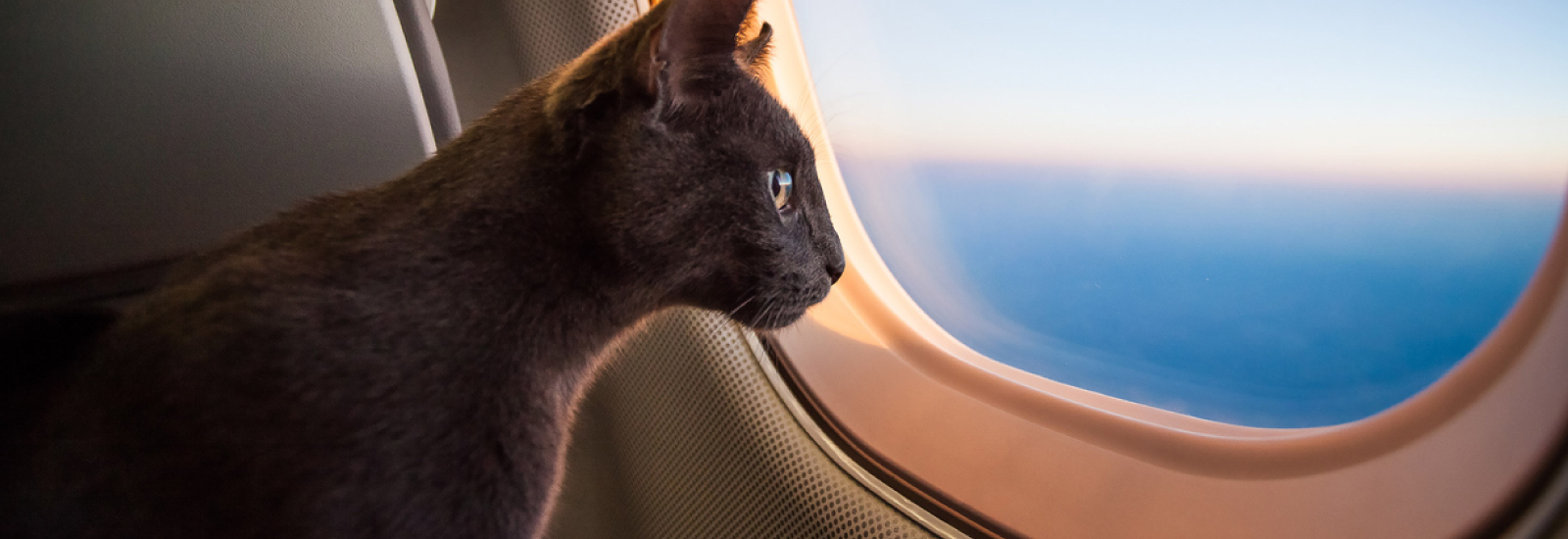Introduction
Moving to a new installation can be tough enough when you’re not moving with pets. If you do throw a pet (or even multiple pets) in the mix, it becomes even more nerve-racking. If you’re someone who has never moved while owning pets, you may not even know where to start.
Good thing you’re here because we’re going to let you in on just about everything you would ever need or want to know when you’re moving with pets during a military move.
Know what information you are looking for? Click the link to jump right to the section.
1. Moving With Pets Checklist
2. Tips For Moving With a Dog
3. Tips For Moving With a Cat
4. Tips For Moving Across Country
5. Pet Transportation Services (Both Continental and International)
6. Tips For Moving Abroad
7. Military Policies and Regulations for Moving With Pets
Moving With Pets Checklist
No matter what kind of pet you have – be it a bird, reptile, cat, dog, or even a fish – there are a few things that you’re always going to want to make sure you have on-hand before beginning a move.
If you’re setting out on a long drive to your next installation, here is a handy-dandy checklist that little Fido is sure to appreciate. We’ll tell you some great things to pack during a long ride and other things to do before setting out for the long haul and once you get there.
1. Pack the Essentials
Think about what YOU would bring for yourself during a long road trip to a brand new place. You’re not going to go on a multi-day or even half-day ride without the basics. Think food, water, grooming supplies (brushes, nail clippers, etc.), litter, and medicine.
You don’t need to pack a ten-pound bag of food for a two-day drive, but make sure you have enough extra to easily access during the chaotic unpacking phase.
2. Pack Creature Comforts
Sure, your pet would survive just getting their normal serving of food and water. However, you also have to think of the stress that comes with moving. If you’re stressed, imagine how your pet is feeling.
Do everything you can to keep them extra comfortable during what is a confusing time for them. Pack some of their favorite snacks (or at least stop for a pup cup or two along the way), get a small travel bed, and throw in a cozy blanket or two just for them.
3. Pack Safety Devices
You wouldn’t let your kids ride without a seatbelt, so think about adding some of that same level of safety for your pet. There are many safe and affordable pet seat belts or harnesses that you can get to give you peace of mind.
Also pack leashes or another similar device if you have a pet that will need to stop outside the car for bathroom breaks during the ride. The last thing you want is for your pet to run away while you’re between installations.
4. Make Sure You Have Identifying Information
Either get all of your pets information tags for their collars or get them microchipped. Better yet, do both!
If something goes wrong during the move, this will be your backup. Don’t forget to update this information with your new address after the move.
5. Let Your Vet Know
You’ll want to inform your vet that you’re moving. This is so that you can get your pet’s medical records (or get them transferred), prescriptions, and grab extra doses of medicine before you head out.
They may also be able to put you in contact with great vets local to your new installation.
6. Check Your New Home for Hidden Dangers
Before bringing your pet into your new home, make sure there is nothing dangerous it can get into.
This includes electrical cords and wires that are hanging or laying out haphazardly. Check that all the windows are closed or have screens (if they are open). Finally, make sure there are no leftover traps, poisons, or potentially toxic cleaning agents laying around that they could get into.
7. Give Them Their Space
Unless your pet has separation anxiety, it’s a good idea to give them space once you arrive at your new home and start moving in. Between going in and out and unpacking, there is going to be a lot of disorder in your home for a bit.
Take your pet’s things and set them up in a special area away from everything else. They can use this area to get acclimated to the new environment.
Moving With a Dog
Moving with a dog can be draining for both you and your four-legged friend if you’re not prepared. Here are some tips to reduce the strain and make moving with a dog easier.
1. Create a Happy Association With Car Rides
If your dog(s) already considers cars to be the place they go to visit the dreaded vet’s office, it’s really important to try to create a welcoming atmosphere inside your vehicle for your dog.
Try bringing your dog into the car and giving them treats. You can also drive them to a dog park or to visit their favorite human (other than you, of course). This way, they’ll associate the car with good things.
2. Make Your Dog Familiar With the Vehicle
We’d suggest getting your dog used to any protective devices you plan on using during your trip, like a dog seat belt or seat covers. Also make sure they’re used to riding in the vehicle while it is in motion.
The more familiar they are with the environment, the less stressful it will be.
3. Leave Out Their Favorite Toys
If you’re like many dog owners, you’ve probably got a box full of toys that your pet likes to play with.
Pick out their favorite two or three, and pack the rest away. Put these in the car next to them when it’s time to move so they stay occupied and happy.
4. Reduce Their Food Intake
The American Kennel Club suggests slightly reducing your dog’s food intake in the week leading up to the trip. If you want to reduce the chances of an accident happening on the road, this is a great way to do it.
5. Take a Walk Around the Block
Once you’ve arrived at your new home, you’re going to want to stretch your legs, and so will your dog.
Grab your leash and take them on a short walk around the neighborhood to get them acclimated to the new area. This gives both pup and parent an opportunity to decompress from the long ride.
Moving With Cats
Cats have different temperaments than dogs, which most cat owners can attest to. They also have many different needs from dogs, so you’ll need to take this into consideration if you have a cat you’re bringing with you during a PCS move.
1. Cat Necessities
If you’re driving rather than shipping cats across the country, you’ll need to make sure you have extra litter and some trash bags on-hand in case you need to change the box on the go.
Portable litter boxes are a MUST for anyone taking their cat on a long ride.
2. Get a Spacious and Comfy Cat Carrier
Many cats won’t tolerate harnesses or pet seat belts. If yours does, consider yourself lucky. The best alternative is to get a comfortable carrier and buckle or strap it in.
3. Get Your Cat Familiar With Its Carrier
Before you set off on your journey, make sure your cat is familiar with its carrier. You can do this by putting it in the carrier with some toys or food for a few minutes a day well ahead of time.
4. Load Your Cat in Last
A great tip to decrease your cat’s unease is to make sure that they are the last thing you load into your vehicle.
If you load them in first and they see you packing things in around them, it might make them uncomfortable and antsy – not the best attitude for starting off a road trip.
5. Introduce Them to the New House Slowly
Cats are incredibly cautious creatures that are not often quick to trust. It’s a good idea to introduce your cat(s) to the new home one room at a time.
This helps them to avoid becoming overwhelmed while they’re still learning the layout of the home and keeps them isolated from the chaos of moving.
Moving Across Country With Pets
Maybe you’re about to embark on a PCS move across just a few states. Or maybe you’re starting out on a partial-DITY move from one coast to another.
No matter how you’re getting to your new installation, your best bet for moving across country with pets will always be to drive with them in the same vehicle. When your pets are in the car with you, they’ll feel more calm and at-ease than they would without you there beside them.
However, we know that’s not always an option for every military family. There are plenty of reputable cross-country pet transport and pet moving services that you can use to make sure your pets receive the greatest possible care. These places make moving with pets infinitely easier on military families.
Cross-Country Pet Transport
We’ve put together a short list of well-reviewed pet moving services that you can use to make sure your pet gets to their new home safely.
So, no matter if you need to ship a dog across the country, ship cats across the country, or even ship a parakeet, these companies can help you do it.
- Happy Tails Travel
Email: PetDesk@HappyTailsTravel.com
Phone: 1 (800) 323-1718
Offers a military discount. - Airpets International
Email: info@airpetsamerica.com
Phone: 1 (866) 738-7447
Offers international transportation. - Animals Away
Email: Must use contact form
Phone: 1 (800) 621-7387
Offers international transportation. - Air Animal
Email: Must use contact form
Phone: (Tampa) 1 (813) 879-3210
Phone: (Orlando) 1 (407) 985-4674
Offers international transportation. - Blue Collar Pet Transportation
Email: reservation@bluecollarpettransport.com
Phone: 1 (888) 208-6669
Offers transportation in Canada.
Note: To use these pet transportation services, your vet will need to give your pet a valid certificate of health. Other rules can be found on each service’s website.
Military Discount Flights That Are Pet-Friendly
Many airlines offer discounts for military members to make moving with pets easier.
We’ve put together a list of just a few that you can count on to help you out during your cross-country move with pets. All airlines on this list also have pet-friendly policies for military members.
-
Allegiant Airlines
Allegiant does not charge for oversized checked baggage. You can bring one carry-on bag and one personal item for free. You can also bring up to one pet in the cabin for free.
-
Alaska Airlines
Alaska Airlines allows military members on travel orders to check up to five carry-on bags for free.
-
United
United offers a 5% discount on tickets for military members.
-
JetBlue
JetBlue offers a 5% discount off of the base fare as well as a baggage waiver of five bags each for both you and your dependents (if applicable).
-
Delta
Active duty military members get more free checked bags during a Delta flight than civilians.
Important note: Short-nosed dogs and cats will usually not be allowed to fly due to potential breathing complications.
Moving Pets Overseas
If you’re being stationed outside of the continental U.S., you can also use many of the pet transportation services listed previously to ship your pet to your new installation. However, international pet transportation can often come with a stricter set of rules and a higher price tag.
Pet Import Laws
You always want to do research on the location of your next installation for their pet import rules. If you’re moving to Hawaii with pets from the continental U.S., there may not be as many stipulations as there may be with moving to another country.
Here are some common rules we see that you’ll need to remember before moving with pets overseas.
- Pets must be microchipped.
- Pets must be vaccinated for rabies. You must provide a copy of the vaccination certificate.
- Pets must have gotten their rabies vaccine 21 days before attempted entry into a country.
- Pets must have an accredited health certificate.
- APHIS (Animal and Plant Health Inspection Service) must counter-sign and seal the health certificate.
- Pets must undergo a preventative tapeworm treatment.
- Pets may be required to undergo isolation to test for different diseases.
If you believe you may be required to return to the U.S. for a future installation change, there are regulations you will have to follow for U.S. pet import, too.
The military also places rules and restrictions on what they can and can’t help you move during an installation change, so make sure you’re familiar with those before setting out.
Policies and Regulations for Moving With Pets
The DoD has certain regulations regarding the type and number of pets military families can bring with them during a PCS.
- A max of two pets per family are allowed to fly with you on AMC (Air Mobility Command) flights.
- Only dogs and cats are allowed on AMC flights.
- This comes with a fee of $80 for pets that weigh 70 lbs. and below. Pets that weigh between 71 lbs. and 99 lbs. cost $160 per pet.
- If you need to transfer more than two pets on AMC, you’ll have to fill out additional waivers for approval.
If you’re moving pets overseas, you may run into a mandatory pet quarantine. If the area where you are moving to requires your pet to be quarantined, the DoD may reimburse you for up to $550 of any associated cost.
Learn more about moving outside of the continental U.S. on our blog OCONUS PCS Move: An In-Depth Guide & 15 Expert Tips (2021 Edition).
Conclusion
So, what to do with pets when moving? Now, you don’t have to wonder. You have plenty of options and tips laid out in front of you. Only you know your pet, their temperament, and their response to different situations. Do what you think is best for them to keep them safe and happy during a turbulent time in their lives and yours.
Have any more tips about moving with pets? Let us know by sharing them on AHRN’s Facebook or tag @ahrncom on Instagram or @AHRNcom on Twitter.







